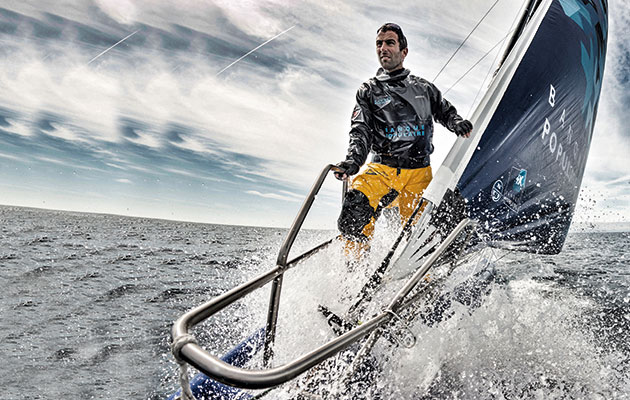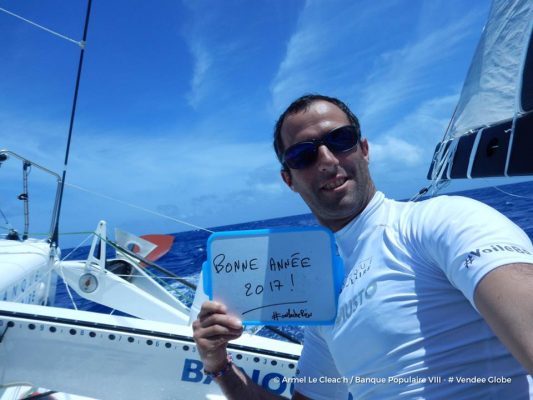Who is Armel le Cléac’h’? The French solo is leading the Vendée Globe fleet home on its final ocean section. We take a look at the Banque Populaire VIII skipper setting out to avenge two runner-up finishes in the race
In his home country, Armel Le Cléac’h’s triumph in the Vendée Globe is seen as the right result. If ever hard work and persistence paid off in sport, this win is the perfect example.
This was the 39-year-old Breton sailor’s third Vendée Globe. In 2009 he finished 2nd behind Michel Desjoyeaux in BritAir. Four years later, he pushed François Gabart to the finish and came barely three hours behind.
This time, he was the pre-race favourite, with a new boat built for him, one of the most professional shore teams in the business and well funded by a good sponsor. His was not the star-is-born victory of Gabart, a wunderkind who won on his first race. Le Cléac’h worked hard to earn it.
It is also a victory of the French system. Le Cléac’h comes from the traditional French style of sailing: he started racing Optimists and 420s as a boy, went on to win a Challenge Espoir Credit Figaro sponsorship scheme (as had Franck Cammas, Yann Eliès and François Gabart), and trained at the Course au Large in Finisterre, France’s solo offshore academy.
He scored two wins in the Solitaires du Figaro, two Transat Ag2r double-handed victories (the only sailor ever to do this) and has twice been 2nd in the Transat Jacques Vabre and the Vendée Globe.
His credentials are rock solid. Le Cléac’h’s local paper, Ouest France, calls him ‘a serial winner’.
A serious man who rarely strays into open emotion, Le Cléac’h is a very different character than the more flamboyant Alex Thomson. The way of ‘The Jackal’ is to attack silently, saying little.
While Thomson made up fictional tales of Speedy the turtle for his son, Le Cléac’h told no stories, described no problems and showed little. During the race, all his videos were taken in the same place; you saw no clues about his sailing set-up.
“Armel is quite quiet. He doesn’t like to show off. He sails the same way and he communicates the same way,” says Banque Populaire team member Yvan Joucla.
“He is very serious. He’s a real ‘marin’, that’s his universe – someone who almost feels better when they’re on a boat.”

Thomson jokingly (but admiringly) referred to Le Cléac’h as “a machine.” Joucla says: “He’s someone who never forgets anything. He’s very meticulous.
“There are many things you can forget to do on these boats and anything you forget can make damage. Armel never does. I would agree: he’s a machine!”
Pierre-Yves Lautrou, a journalist with L’Express and fellow Breton offshore sailor, has followed Le Cléac’h for many years. “There’s no secret, no story. He’d be the guy you’d see in town with his family.
“He is very discreet and respectful. He’s from a part of Brittany that’s very Catholic and very simple; that’s the life.”
For relaxation he says Le Cléac’h enjoys sports, Star Wars, and the works of JRR Tolkien.
At the finish, when Armel Le Cléac’h put his face in his hands and sobbed with relief, Twitter went mad: at last, emotion.
It did no harm, either, that the contest was also a test of nations. “It was the never-ending story of history,” says Lautrou.“French versus English.”
It’s a story that is never forgotten in Brittany. The castle right in the middle of the Bay of Morlaix where Le Cléac’h grew up sailing was built to defend against the English.
And when he brought his press conference after the finish to a conclusion, Le Cléac’h introduced his shore team, one by one, and said: “We won the race. And we beat the Englishman!”
———————————————————–
Nicknamed ‘the Jackal’ for his ruthless ability to hunt down any opposition, writes Helen Fretter, Armel le Cléac’h is one of France’s most impressive offshore sailing talents.
Analytical, supremely competitive and professional, le Cléac’h is an adversary to be feared.
Following the well-trodden path of many successful French short-handed sailors, he announced his arrival on the solo scene in his first Solitaire du Figaro in 2000 by taking the prestigious ‘bizuth’ prize for top placed first-timer. He went on to win the Figaro three years later, and again in 2010. He also twice won the Transat AG2R (2004 and 2010).
After a spell in the ORMA trimaran fleet, he moved into the IMOCA 60 class in 2006, then sponsored by BritAir, and rapidly became one of the most serious competitors on the circuit. He was IMOCA champion in 2008, and topped off two Figaro event wins in 2010 with a second in the year’s Route du Rhum in the IMOCA.
Sponsored by Banque Populaire since 2011, he scored some impressive podium results for the partnership, including 3rd in the two-handed Transat Jacques Vabre race from France to Brazil, and set a single-handed 24-hour record of 673 miles in 2014, averaging 28.20 knots on Banque Populaire VII.
But twice he has come home in 2nd place in the Vendée Globe – a supreme achievement for any sailor, but also a gut-wrenching disappointment for one as competitive as Le Cléac’h with a solid, well-prepared and funded campaign behind him.

The foil-assisted IMOCA Banque Populaire VIII
His bid for the 2016 Vendée Globe got off to a strong start when he won The Transat solo race from Plymouth to New York with his 2015-launched, VPLP-Verdier-designed Banque Populaire VIII in the first test of the new generation foil-assisted IMOCA 60s.
But on the return leg back to Les Sables d’Olonne from New York, he collided with what was described as a ‘large unknown fish’, breaking up one foil and causing other damage to the yacht.
History repeats
Fully repaired, Banque Populaire VIII and skipper headed into this year’s Vendee Globe as favourite for many pundits. He took the lead from Alex Thomson on Hugo Boss on 3 December, 2016, and for almost a month appeared increasingly unreachable as Banque Populaire VIII extended away from Thomson’s wounded Hugo Boss, with its destroyed starboard foil.
But Thomson was not about to let Le Cléac’h get away quite so easily. As Banque Populaire began negotiating a high pressure ridge in the South Atlantic, Thomson flew around Cape Horn to reduce a deficit of over 800 miles to less than 100 over the course of a week, reducing Le Cleac’h’s theoretical advantage to just 28 miles on Friday 30 December. The hunter had become the hunted.
But as the high pressure zone extended across Thomson’s more easterly route, Le Cleac’h’s advantage expanded once again. He headed into 2017 with around a 150 mile lead – not insurmountable, but not insignificant, and a familiar scenario for Le Cleac’h.
“Four years ago, off Argentina, Francois [Gabart] had about the same lead that I have, and he managed to keep that up right the way to the finish,” Le Cleac’h commented in a special New Year’s Day broadcast for French television.
“Right now, there’s only three hours separating me and Alex so I’ll hopefully be able to use my experience of that time to push harder and that will be helped by the close contact racing I’ve had of late. But Alex has that same experience of course so we both know what needs doing.”

Sailing the remotest reaches of the world’s oceans, Vendée Globe skippers have few luxuries, but secrecy is one comfort they may guard greedily. This race has been no exception, with Le Cléac’h revealing in the broadcast that he had had some repairs to make to Banque Populaire, but not what they entailed.
Observers will be watching closely for clues to any chink in Le Cléac’h’s armour as he and Thomson progress up the North Atlantic. The toll this year’s relentless pace – Le Cléac’h rounded Cape Horn after 47 days of racing, smashing the 2012-2013 record set by last race winner François Gabart by more than five days – has exacted on Banque Populaire VIII and Hugo Boss is likely to only become visible when they arrive back in Les Sables d’Olonne, currently predicted to be between 14-16 January, 2017.
This morning sees the duo beating upwind, making miles to the north and east as they chase the easterly trade winds. Both are likely to hook into the trade winds within the next 24 hours. Then it will be around 4,000 miles to the finish. Will 2017 finally be the year of the Jackal?




